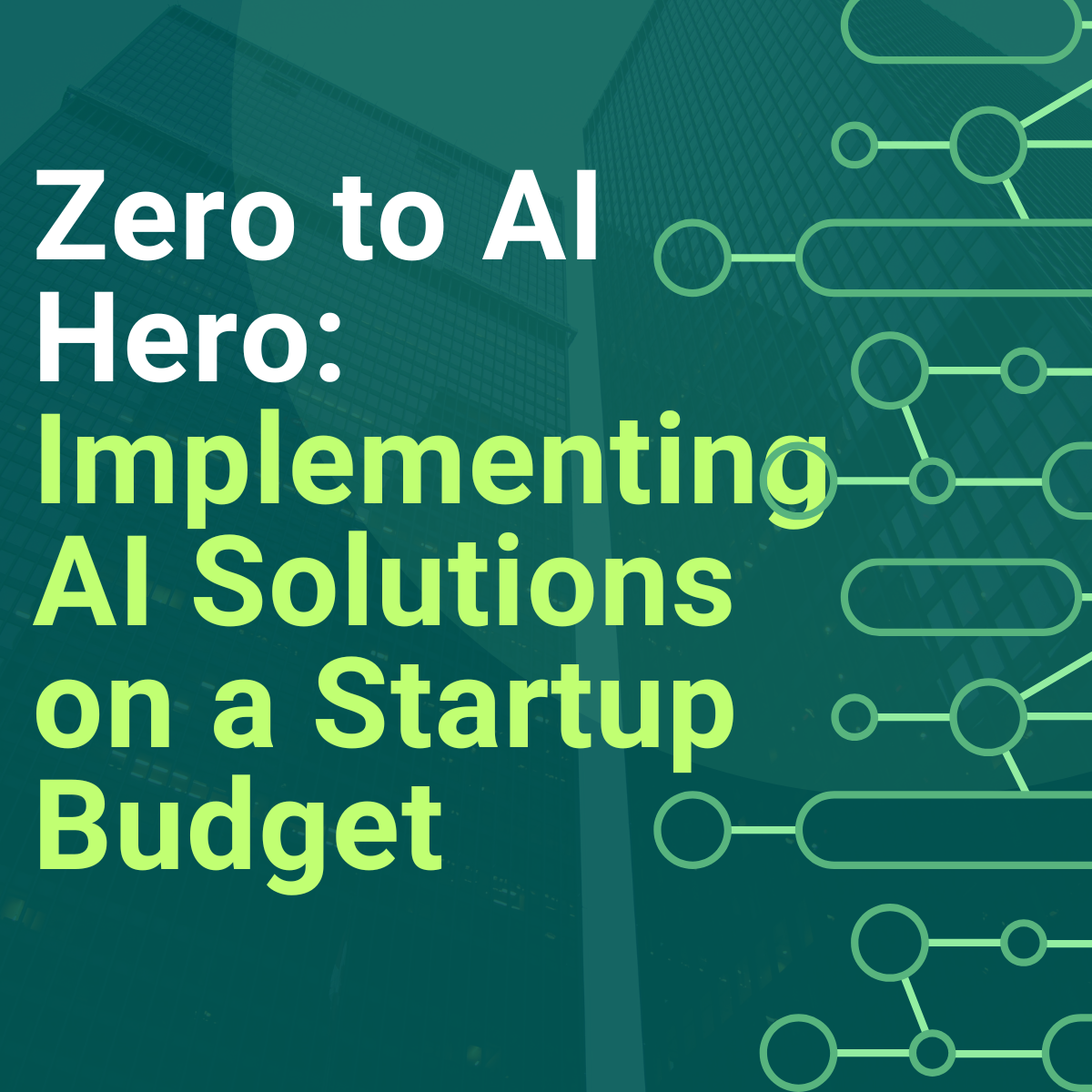AI isn’t just for the big tech companies anymore. These days, even small startups with tight budgets are discovering the power of artificial intelligence. If you’ve ever thought, “We can’t afford AI,” it might be time to think again.
There’s a common myth that AI solutions are expensive and require massive technical teams. But in 2025, affordable AI tools are more accessible than ever. Thanks to open-source models, cloud platforms, and no-code tools, you can now bring AI into your business without needing a million-dollar budget.
According to recent surveys, nearly 45% of small businesses are already using AI in some form, whether for customer support, marketing, or analytics. That means you’re not too early—and definitely not too late. You’re right on time.
In this guide, you’ll learn:
- How to spot where AI can help your business the most
- The best low-cost tools for implementing AI solutions
- Real startup case studies that proved you don’t need big money to win with AI
- A step-by-step road map to get you from AI beginner to confident implementer
Let’s get started on turning your startup into an AI-powered business machine.
Why Every Startup Needs an AI Strategy (And How It’s More Accessible Than Ever)
The Democratization of AI
In 2025, AI is no longer locked behind corporate doors. Three key changes have made startup artificial intelligence possible:
- Open-source models like Meta’s LLaMA and Mistral let anyone experiment and build without license fees.
- Cloud-based AI services from Google, AWS, and Microsoft let you rent powerful tools without owning servers.
- No-code/low-code platforms like Bubble, Make, and Zapier let non-engineers build AI workflows quickly.
Common Startup AI Use Cases
You don’t need a complex product to benefit from AI. Many startups use AI in these ways:
- Customer service: Smart chatbots, ticket routing, 24/7 support
- Content creation: Blogs, emails, social posts written by AI
- Data analysis: Automatic reports, customer insights
- Process automation: Invoice processing, lead follow-up, scheduling
- Sales: Predictive lead scoring, personalized messaging
ROI Expectations
Don’t expect magic overnight. But AI can save time and money fast when used right.
- Quick wins might show up in 2-3 months
- Bigger returns (like revenue growth or reduced costs) often take 6+ months
- Track metrics that matter: hours saved, cost per lead, response time, customer ratings
Avoid “AI washing” (claiming to use AI when it’s not adding value). The goal is real impact, not buzzwords.
Before You Build: Mapping Your AI Opportunity Landscape
Identifying Your AI-Ready Processes
Start by spotting repetitive tasks that drain time. Examples include:
- Manual data entry
- Repeating the same answers to customers
- Writing similar types of content
- Creating weekly reports by hand
Ask yourself:
- “What tasks feel robotic?”
- “Where do we spend the most time doing low-value work?”
Data Availability Assessment
AI runs on data. So check:
- What data are you collecting? (emails, chats, transactions, user behavior)
- Is it clean and consistent? AI struggles with messy or incomplete data.
- Are you following privacy rules? Stay compliant with GDPR or other data laws.
- Do you need more data? Start collecting now to benefit later.
Setting Realistic Goals and Budgets
Suggested budget split for small businesses:
- 70% for tools and platforms (chatbots, writing tools, automation apps)
- 20% for training and education
- 10% for experiments and pilots
Timeline expectations:
- 0-3 months: Small wins (like automated emails or basic chatbots)
- 3-6 months: Better analytics, smarter workflows
- 6+ months: Custom AI models or full process overhauls
Building Your AI Team (Without Hiring Experts)
You likely don’t need to hire an AI engineer right away. Instead:
- Find internal champions who enjoy learning new tools
- Train your team with online courses (Coursera, Udemy, HubSpot)
- Use contractors for short-term help (Upwork, Toptal)
- Join communities like Indie Hackers or Reddit’s r/MachineLearning for support
Your First AI Victories: Maximum Impact, Minimum Investment
Customer Service Automation
Start with chatbots. They’re fast to deploy and can drastically cut support costs.
- Tools: Intercom, Zendesk, Tidio, or custom bots using ChatGPT API
- Cost: As low as $20/month for basic plans
- Tips:
- Train bots on your FAQs
- Add human fallback options
- Monitor performance weekly
Bonus: Add AI email assistants to categorize, prioritize, and even respond to customer emails.
- Sentiment analysis = flag angry customers fast
- Auto-responders = faster response times
Content Creation and Marketing
AI can supercharge your content without hiring a full team.
Text Content Tools:
- Blog generation: ChatGPT, Claude, Jasper, Copy.ai
- Email marketing: Personalized sequences via Instantly.ai or Mailchimp AI
- Social content: Scheduling + writing with Buffer or Hootsuite integrations
Visual Content Tools:
- Images: DALL•E, Midjourney, Canva Pro AI, Fotor
- Video: Pictory, RunwayML, Descript for editing
Data Analysis and Insights
Automate reporting using built-in AI in tools like:
- Google Analytics
- Meta Ads Manager
- HubSpot or Zoho CRM
Predictive analytics on a budget:
- Lifetime value prediction
- Inventory forecasting
- Lead scoring
Tools: DataRobot, MonkeyLearn, Obviously.ai, or spreadsheets + GPT
Level Up: Building More Sophisticated AI Solutions
Custom AI Model Development
When to go custom:
- You’ve maxed out basic tools
- You have unique data or niche workflows
- Off-the-shelf solutions aren’t enough
Cost-saving tips:
- Fine-tune existing models (like GPT-4 or LLaMA)
- Use cloud training platforms (Google Vertex AI, AWS SageMaker)
- Reuse pre-trained models to reduce time and cost
Integration and Workflow Optimization
AI shines brightest when connected to your daily tools.
Use APIs + automation tools:
- Zapier or Make for simple flows
- n8n or Pipedream for advanced setups
Examples:
- New lead comes in → AI writes welcome email → Email sent automatically
- Monthly sales report → Summarized by AI → Shared to Slack
Advanced Use Cases
- Personalization engines: Smart product recommendations, customized landing pages
- Predictive operations: Auto-ordering based on demand, resource optimization
- Quality control: Anomaly detection in customer feedback or production
Your AI Toolkit: The Best Budget-Friendly Platforms for Startups
No-Code/Low-Code Platform Comparison
| Platform | Best For | Price | Learning Curve | Notes |
|---|---|---|---|---|
| Zapier | Automation | Free – $20/mo | Easy | Good starter tool |
| ChatGPT API | Content, chat | $0.01-$0.03 per query | Medium | Great for custom bots |
| Pictory | Video editing | $19/mo | Easy | Auto video creation from blogs |
| DALL•E | Image generation | Pay-per-use | Easy | Visual assets on demand |
Category Recommendations
- Customer Service: Intercom, Zendesk, Tidio
- Content Creation: ChatGPT, Claude, Jasper
- Data Analysis: Google Cloud AI, DataRobot, Obviously.ai
- Automation: Zapier, Make, UiPath
Open-Source Options
- Hugging Face (models + tutorials)
- FastAPI (build AI APIs)
- LangChain (LLM apps with memory)
Pros:
- Free to use
- Large support communities
Cons:
- May require basic coding knowledge
- Security and compliance need extra attention
Success Stories: How These Startups Implemented AI on Shoestring Budgets
Case Study 1: E-commerce Startup
- Problem: Too many customer service requests
- Solution: Added chatbot + order tracking bot
- Budget: $500/month
- Result: 60% fewer support tickets, faster response time
Case Study 2: SaaS Company
- Problem: No time for regular blog posts
- Solution: Used ChatGPT to generate weekly SEO content
- Budget: $200/month
- Result: 3x more organic traffic in 4 months
Case Study 3: Local Service Business
- Problem: Wasted time chasing bad leads
- Solution: CRM + AI scoring for lead quality
- Budget: $800/month
- Result: 40% more conversions from same traffic
Key Lessons:
- Start small
- Use off-the-shelf tools first
- Test, measure, iterate
Proving Value: How to Measure Your AI Implementation Success
Key Performance Indicators (KPIs)
Efficiency Metrics:
- Time saved per task
- % of tasks automated
- Error reduction rates
Business Metrics:
- Revenue per employee
- Customer satisfaction scores (CSAT)
- Cost per lead or acquisition
ROI Calculation Framework
- Estimate time or money saved monthly
- Add in revenue from AI-generated content or faster sales
- Subtract tool costs
- Project ROI over 6-12 months
Example:
- $1,000 saved/month in support hours
- $300 tool cost = $700 net/month
- ROI = $8,400/year gain
Optimization Tips
- Run A/B tests to compare manual vs. AI performance
- Use feedback loops to train models
- Scale winning pilots into other departments
Learning from Others’ Mistakes: AI Implementation Pitfalls to Avoid
Technical Pitfalls:
- Trying to build everything custom too early
- Using bad data (garbage in = garbage out)
- Not testing tools properly before scaling
Business Pitfalls:
- Setting wild expectations
- Not preparing your team for change
- Skipping user training
Budget Pitfalls:
- Underestimating implementation time
- Forgetting ongoing costs
- Getting stuck with one expensive vendor
Tip: Always start with a small, affordable pilot project before expanding.
Ready to Start? Your Step-by-Step 90-Day AI Implementation Roadmap
Days 1-30: Foundation
- List repetitive or time-consuming tasks
- Identify internal team members who can learn AI tools
- Research and test 2-3 affordable platforms
- Launch one pilot project (ex: chatbot or blog automation)
Days 31-60: Implementation
- Expand data collection and tracking
- Monitor your pilot project’s results
- Adjust workflows based on what’s working
- Train more team members if needed
Days 61-90: Scaling
- Measure ROI and document outcomes
- Identify 1-2 more use cases to automate
- Build internal knowledge base or AI playbook
- Celebrate wins and share across the team!
From AI Novice to Implementation Hero: Your Journey Continues
You don’t need to be a tech wizard to use AI in your startup. With the right tools and strategy, even the smallest business can unlock massive value from AI.
Remember:
- Focus on high-impact, low-effort wins first
- Stay curious and keep learning
- Track results and grow step-by-step
Want to keep building?
- Take a free course on AI from Coursera or Google
- Join communities like Indie Hackers, AI Exchange, or Product Hunt
- Subscribe to AI-focused newsletters like Ben’s Bites or The Rundown AI
Ready to get started?
- Download our AI Implementation Checklist
- Share your first AI win with us on social media
- Bookmark this guide for your team
You’ve got the tools. Now build your AI-powered future!


